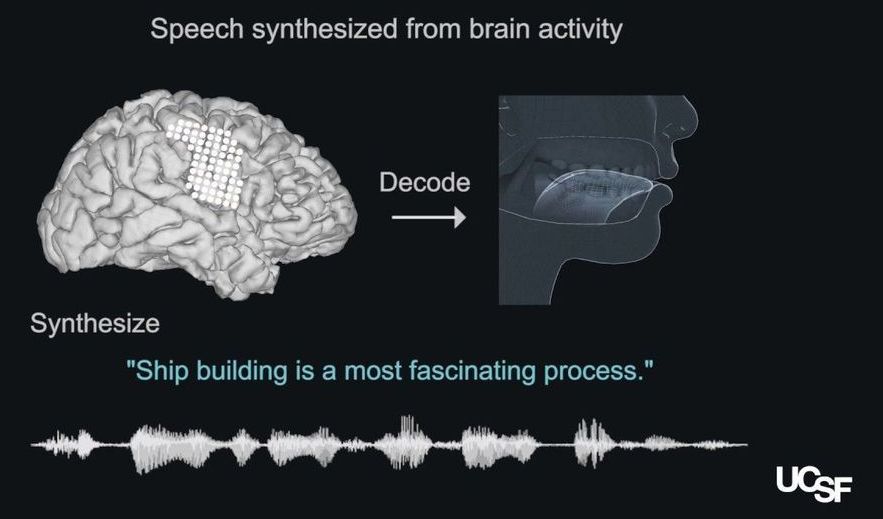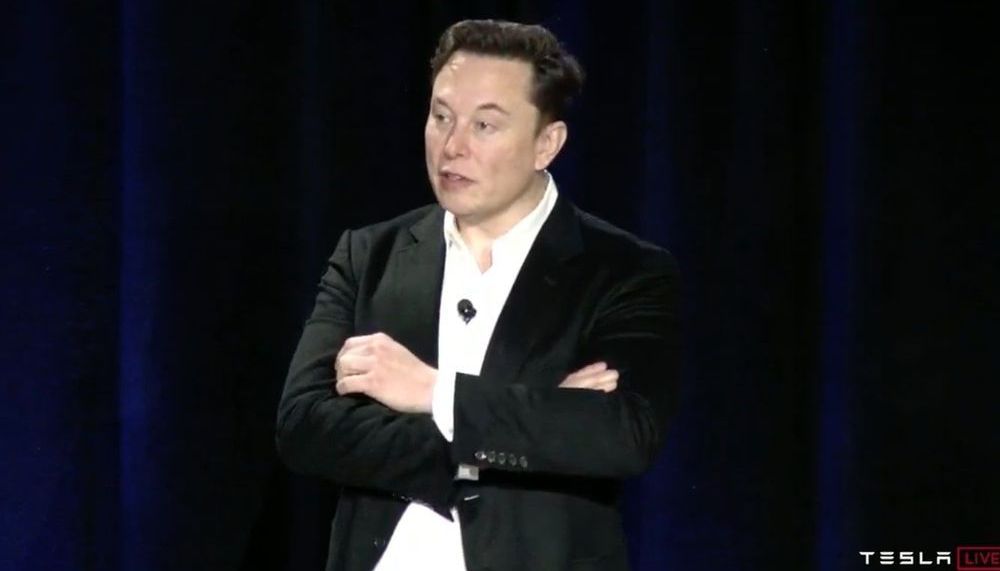Page 8854
Apr 24, 2019
Synthetic speech generated from brain recordings
Posted by Mike Ruban in categories: biotech/medical, computing, neuroscience

A state-of-the-art brain-machine interface created by UC San Francisco neuroscientists can generate natural-sounding synthetic speech by using brain activity to control a virtual vocal tract—an anatomically detailed computer simulation including the lips, jaw, tongue, and larynx. The study was conducted in research participants with intact speech, but the technology could one day restore the voices of people who have lost the ability to speak due to paralysis and other forms of neurological damage.
Stroke, traumatic brain injury, and neurodegenerative diseases such as Parkinson’s disease, multiple sclerosis, and amyotrophic lateral sclerosis (ALS, or Lou Gehrig’s disease) often result in an irreversible loss of the ability to speak. Some people with severe speech disabilities learn to spell out their thoughts letter-by-letter using assistive devices that track very small eye or facial muscle movements. However, producing text or synthesized speech with such devices is laborious, error-prone, and painfully slow, typically permitting a maximum of 10 words per minute, compared to the 100–150 words per minute of natural speech.
Continue reading “Synthetic speech generated from brain recordings” »
Apr 24, 2019
China to build moon station in ‘about 10 years’
Posted by Quinn Sena in category: space travel
Beijing plans to send a manned mission to the moon and to build a research station there within the next decade, state media reported Wednesday, citing a top space official.
China aims to achieve space superpower status and took a major step towards that goal when it became the first nation to land a rover on the far side of the moon in January.
It now plans to build a scientific research station on the moon’s south pole within the next 10 years, China National Space Administration head Zhang Kejian said during a speech marking “Space Day”, the official Xinhua news agency reported.
Continue reading “China to build moon station in ‘about 10 years’” »
Apr 24, 2019
Imaging system helps surgeons remove tiny ovarian tumors
Posted by Quinn Sena in category: biotech/medical
Ovarian cancer is usually diagnosed only after it has reached an advanced stage, with many tumors spread throughout the abdomen. Most patients undergo surgery to remove as many of these tumors as possible, but because some are so small and widespread, it is difficult to eradicate all of them.
Researchers at MIT, working with surgeons and oncologists at Massachusetts General Hospital (MGH), have now developed a way to improve the accuracy of this surgery, called debulking. Using a novel fluorescence imaging system, they were able to find and remove tumors as small as 0.3 millimeters—smaller than a poppy seed—during surgery in mice. Mice that underwent this type of image-guided surgery survived 40 percent longer than those who had tumors removed without the guided system.
“What’s nice about this system is that it allows for real-time information about the size, depth, and distribution of tumors,” says Angela Belcher, the James Mason Crafts Professor of Biological Engineering and Materials Science at MIT, a member of the Koch Institute for Integrative Cancer Research, and the recently appointed head of MIT’s Department of Biological Engineering.
Continue reading “Imaging system helps surgeons remove tiny ovarian tumors” »
Apr 24, 2019
Solving a Math Problem Just Brought Holograms Closer to Reality
Posted by Quinn Sena in categories: holograms, mathematics
Holograms are a staple in science fiction, but creating ones detailed enough to have serious applications in the real world has proved difficult. While scientists have been slowly pushing the field of holographic projection forward, they haven’t been able to overcome a problem called cross-talk. However, in a recent paper published in Nature, they have been able to manipulate the shape of light to overcome this, thus allowing them to produce 3D holograms that are orders of magnitude clearer, larger, and more detailed.
What Are Holograms?
Simple holograms are 2D surfaces that produce the illusion of a 3D object when light is shined through it.
Continue reading “Solving a Math Problem Just Brought Holograms Closer to Reality” »
Apr 24, 2019
Telsa Will Make an Electric Leafblower As Garden Equipment is a Big Pollution Source
Posted by Quinn Sena in categories: Elon Musk, sustainability, transportation
Elon Musk has tweeted that Tesla will make a quiet electric leaf blower.
In 2017, the California Air Resources Board, said that by 2020, the biggest single ozone polluter in California is going to be all this gardening equipment.
California has 16 million gas-powered garden machines from leaf blowers to mowers.
Apr 24, 2019
A first in medical robotics: Autonomous navigation inside the body
Posted by Quinn Sena in categories: bioengineering, biotech/medical, robotics/AI
Bioengineers at Boston Children’s Hospital report the first demonstration of a robot able to navigate autonomously inside the body. In an animal model of cardiac valve repair, the team programmed a robotic catheter to find its way along the walls of a beating, blood-filled heart to a leaky valve—without a surgeon’s guidance. They report their work today in Science Robotics.
Surgeons have used robots operated by joysticks for more than a decade, and teams have shown that tiny robots can be steered through the body by external forces such as magnetism. However, senior investigator Pierre Dupont, Ph.D., chief of Pediatric Cardiac Bioengineering at Boston Children’s, says that to his knowledge, this is the first report of the equivalent of a self-driving car navigating to a desired destination inside the body.
Dupont envisions autonomous robots assisting surgeons in complex operations, reducing fatigue and freeing surgeons to focus on the most difficult maneuvers, improving outcomes.
Continue reading “A first in medical robotics: Autonomous navigation inside the body” »
Apr 24, 2019
A new clue in the mystery of ALS, frontotemporal dementia
Posted by Quinn Sena in categories: biotech/medical, genetics, neuroscience
A special focus on rogue proteins may hold future promise in stopping the progression of nerve cell destruction in people who have amyotrophic lateral sclerosis (ALS) or frontotemporal dementia.
ALS, a rare but devastating disorder that’s also known as Lou Gehrig’s disease, attacks the body’s nerve cells, resulting in progressive muscle weakness as the neurons degenerate over time. There is no cure. People with ALS eventually lose their strength and the ability to move their arms, legs and body.
About a third of those with ALS also develop frontotemporal dementia (FTD), a destruction of neurons in the brain that causes profound personality changes and disability. The two diseases are similar in both pathology and genetics. FTD tends to affect people earlier than Alzheimer’s disease, the most common type of dementia.
Continue reading “A new clue in the mystery of ALS, frontotemporal dementia” »
Apr 24, 2019
Atom interaction discovery valuable for future quantum technologies
Posted by Quinn Sena in categories: particle physics, quantum physics
By breaking with conventionality, University of Otago physicists have opened up new research and technology opportunities involving the basic building block of the world—atoms.
In a study, just published in Nature Communications, researchers put one atom inside each of two laser beams before moving them together until they started to interact with each other.
Co-author Associate Professor Mikkel F. Andersen, of the Department of Physics, says this allows the atoms to exchange properties in a way which could be “very useful” for future quantum technologies.
Continue reading “Atom interaction discovery valuable for future quantum technologies” »
Apr 24, 2019
Electron qubit non-destructively read: Silicon qubits may be better
Posted by Genevieve Klien in categories: computing, quantum physics
I suspect that if you asked an engineer at Intel about quantum computing, they probably wouldn’t want to know about it unless the chips could be fabricated using standard fabrication technology. Using standard processes means using electrons as the basis for quantum computing.
Electrons are lovely in many respects, but they are rather extroverted. It doesn’t matter what you do, they will run off and play with the neighbors. The constantly interacting electron does not look after its quantum state, so quantum information is rapidly lost, making processing really difficult. This makes the achievement of a quantum non-demolition measurement in an electron system rather remarkable.
















